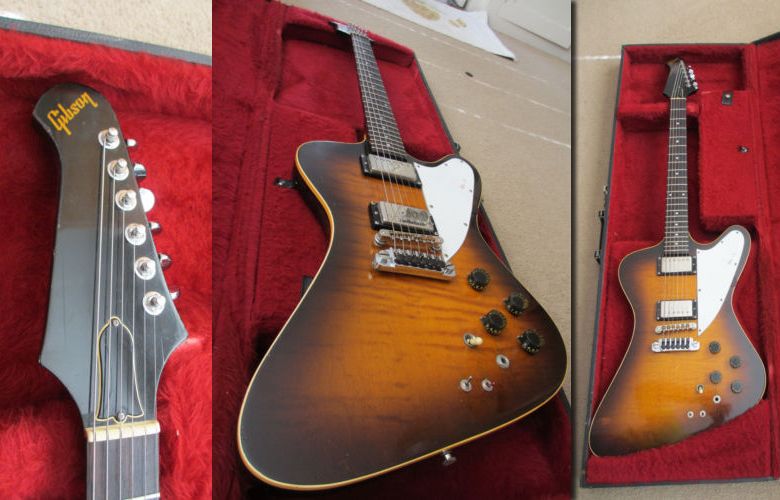Here's an unusual take on the Firebird design from Gibson. To quote from the eBay listing:
Very rare and unique 1981 Gibson Firebird II Artist CMT. Reportedly only about 160 or so of this model were made. Maple body with bound flamed curly maple top in Antique Sunburst (tobacco burst) finish.Currently listed on eBay (with the original Moog circuit boards and original Series VI low-impedance pickups should you want them) with a starting bid of $2,100.
These guitars originally came with the same Moog-designed active electronics from Gibson's "RD Artist" series, with compression (neck pickup) and expansion (bridge pickup) options available. Many musicians found that circuitry too complex, especially on stage, and the RD series was a commercial failure...
G L Wilson
© 2013, Guitarz - The Original Guitar Blog - the blog that goes all the way to 11!
Please read our photo and content policy.


My guess is that Gibson was sitting on a ton of A E parts and wanted to unload them by using the Firebird name. Maple body has to be funking heavy. Pretty weird time for Gibson, as they would soon be abandoning Michigan for less union-friendly Tennessee.
ReplyDeleteWow. This was surely a time of identity crisis for Gibson. It really doesn't know which leg to stand on, does it? Is it an attempt to traditionalize the RD or och make the Firebird more contemporary?? In the latter case, they certainly managed to eliminate everything that was unique about the FB: no through neck, mini humbuckers or banjo tuners. It's more like a weirdly shaped Les Paul. Nice-looking instrument on it's own terms, though.
ReplyDeleteThis is actually my guitar; thanks for posting it, Mr. Wilson. To Rotter's comment, the Firebird II is significantly less heavy than my maple-bodied Explorer II CMT, probably because the Firebird body's pretty thin and there's a big chamber routed into the back of it where the Moog board was. When I've gigged it, I've always been more conscious of its length than its weight.
ReplyDeleteNever seen one of them! I've seen the Les Paul take and of course the ES335 take as much used by Steve Howe in Asia but this is cool - being as it is funnny that the RD design to first feature the artist like electrics was a sort of "inspired by" the Firebird shape. Neat guitar
ReplyDeleteUnknown wrote: "Is it an attempt to traditionalize the RD or [to] make the Firebird more contemporary?"
ReplyDeleteI think it was the former. In the book "50 Years of the Gibson Les Paul" they discuss the Les Paul Artist, which incorporated the same circuitry. The book says that Gibson first thought the failure of the RD models, introduced in '77, was mostly due to the unusual styling, and "that the solution was to transplant the technology over to some traditional guitar designs." Tim Shaw is quoted as saying that they first tried putting it into the LP and ES models, which required redesigning the circuit board to fit and removing a lot of wood, but that ultimately he realized that guitarists are conservative, and that "nobody really wanted a Les Paul that did all that."
Shaw also says there that "Somebody once said that with one of those Artists you were always a flick of a switch away from total disaster." Reading that quote was what made me decide to gut & rewire the guitar above rather than try to restore the Moog circuitry. That stuff might be cool for recording, but if you're gigging and need to switch sounds quickly mid-song, there's just too many parameters to dial in (the tone controls also were active, I think it was a notch filter EQ but not 100% sure).
The Artist models were an elite line when they were released - all the guitar hardware and construction is superior and many new features were added Brass nut, New Tune-O-Matic bridge assembly, Flip out tuners, etc.. My ES plays like a dream. True the Moog electronics provide dubious benefits and that type circuitry does not age well in a guitar environment - so the benefits of the Moog (Considerably) diminish overtime. Swapping out the original P/Us and pots is an option I'm preparing to do - while saving the orginal Moog for resale - if that should occur. Saving the Moog will also save it from deterioration - properly saved in an environment that will not add to the deterioration. The guitar's collectability will increase overtime as so few units were made. For that reason alone the Artist line models are worth considering. As far as playability - Excellent in my opinion.
ReplyDeletei had one. it sucked.
ReplyDelete